Sir Laurence Alma-Tadema (1836–1912), who was born in the Frisian town of Dronrijp, painted this scene in 1881. He called it Amo te ama me, which literally translates into ‘I love you, so love me too.’
Tadema painted the amorous couple in a Roman setting as is evident from the marble seat and the couple´s clothing. But this is a love that could just as well be happening right now. Tadema’s fans simply adored these types of paintings. Roman antiquity was highly fashionable at the time and scenes such as these weren’t difficult to understand. His vivid paintings draw in the spectator. Some details are breathtakingly realistic, for example, the marble which almost seems translucent.
Tadema´s success drew clients from all over the world to his house in London, commissioning paintings from his hand. This painting was commissioned for the residence of the immensely wealthy banker Henry Marquand in New York. Tadema knew exactly what his audience wanted to see, and he had moved to London because he knew his paintings would sell better there. His large house and studio – decorated from top to bottom in Roman style – were famous, and Tadema became a wealthy man. However, when he died in 1912, these types of settings were considered too saccharine and had become outmoded. All of a sudden a work by Tadema was seen as kitsch, of no value, and was no longer in demand.

